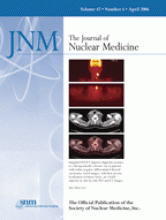Basics of PET Imaging: Physics, Chemistry, and Regulations
G.B. Saha, ed.
New York, NY: Springer, 2005, 206 pages, $59.95
Molecular biologic discoveries have great implications for disease prevention, detection, and targeted therapy. Molecular diagnostics (i.e., prostate-specific antigen, CA-125, Ki-67, estrogen receptor, progesterone receptor, androgen receptor) are sensitive prognostic tools but not specific to predict the treatment outcome of the disease. Though the specificity could be improved by combining these tools with other molecular markers, yet the sensitivity of the molecular diagnostics would be altered. In vivo molecular imaging agents are able to provide cellular and molecular information. PET is a unique form of CT that produces images of biochemical and physiologic processes in tissues, as opposed to anatomically based imaging methods such as CT and MRI. PET radiotracers can be used to monitor the effectiveness or ineffectiveness of therapies. With a quantitative biochemical-imaging tool, the physician can maximize the proper therapeutic regimen by quantifying and predicting a specific biologic response to an agent in each patient. In addition, quantitative PET may allow the rapid development of new drugs. The first chapter of Basics of PET Imaging: Physics, Chemistry, and Regulations provides an overview of radiation decay mode.
To increase the diagnostic accuracy of PET tracers, PET instrumentation must be improved. The combination of CT morphologic/anatomic information and these new mechanism-based PET tracers should provide for accurate assessment of target function and image-guided therapy. Chapters 2 and 3 describe PET and PET/CT systems and their data acquisition. The successful development of a camera that is a hybrid between PET and CT is making CT almost a standard component of any PET purchase. CT-derived anatomic maps are being used to correct attenuation and improve diagnostic accuracy. Chapters 4 and 5 provide an overview of PET image reconstruction and the performance characteristics of PET scanners.
Application of molecular targets for disease imaging, therapy, and prevention using cyclotron and generator-produced isotopes are the major focus of ongoing research projects. Chapter 6 describes the production of PET radionuclides. Generator-produced PET isotopes such as 82Rb, 62Cu, and 68Ga should be preferred in clinical practice over cyclotron-produced isotopes because of ease of access and cost. Chapter 7 describes the synthesis and cyclic guanosine monophosphate automation of PET radiopharmaceuticals. 18F-FDG PET has long been used to assess increased glucose consumption by malignant cells, but problems with specificity for cell proliferation have led to the development of new tracers. Molecular targets for neuroreceptor mapping, amino acid transporters, nucleoside proliferators, and perfusion and metabolic imaging are discussed. However, other molecular targets such as hypoxia, cell apoptosis, angiogenesis (epidermal growth factor receptor), multidrug resistance, peptide imaging, hormonal receptors, gene expression, and their biologic correlations are not described. Chapter 8 and 9 give an excellent review of regulatory compliance and reimbursement for PET procedures. The design of PET centers and procedures for PET are described in the last chapter.
Overall, this book provides a basis for the understanding of PET isotopes, radiopharmaceutical development, PET instrumentation design, regulatory compliance, patient management, and PET center design. Adequate references are cited. I recommend this book to any imaging scientists or students, especially those who are preparing for the board examination of imaging specialties.







